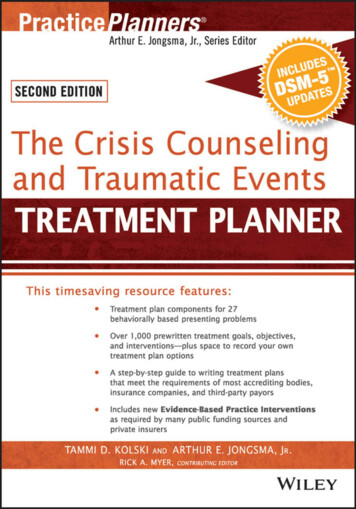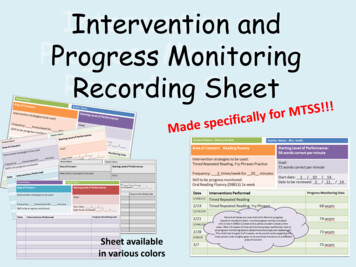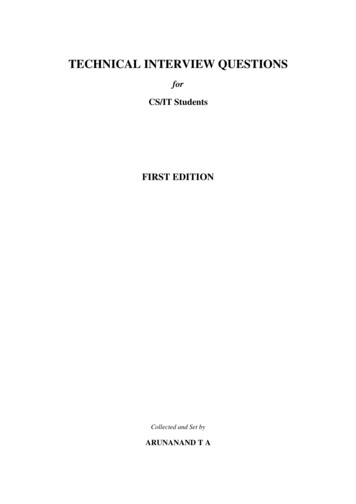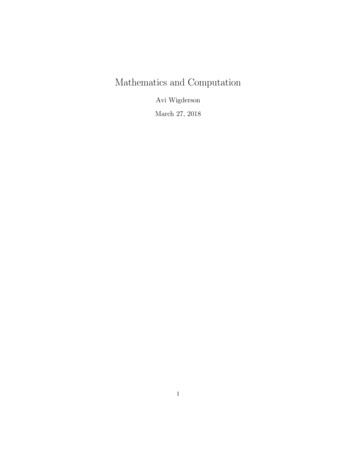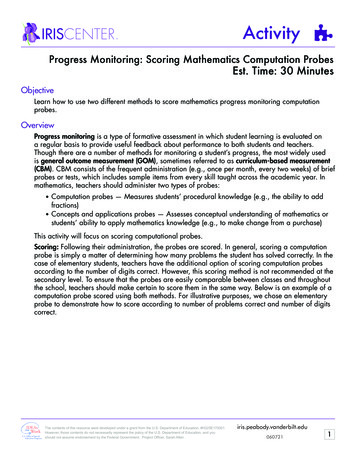
Transcription
Activity Progress Monitoring: Scoring Mathematics Computation ProbesEst. Time: 30 MinutesObjectiveLearn how to use two different methods to score mathematics progress monitoring computationprobes.OverviewProgress monitoring is a type of formative assessment in which student learning is evaluated ona regular basis to provide useful feedback about performance to both students and teachers.Though there are a number of methods for monitoring a student’s progress, the most widely usedis general outcome measurement (GOM), sometimes referred to as curriculum-based measurement(CBM). CBM consists of the frequent administration (e.g., once per month, every two weeks) of briefprobes or tests, which includes sample items from every skill taught across the academic year. Inmathematics, teachers should administer two types of probes:Computation probes — Measures students’ procedural knowledge (e.g., the ability to addfractions) Concepts and applications probes — Assesses conceptual understanding of mathematics orstudents’ ability to apply mathematics knowledge (e.g., to make change from a purchase) This activity will focus on scoring computational probes.Scoring: Following their administration, the probes are scored. In general, scoring a computationprobe is simply a matter of determining how many problems the student has solved correctly. In thecase of elementary students, teachers have the additional option of scoring computation probesaccording to the number of digits correct. However, this scoring method is not recommended at thesecondary level. To ensure that the probes are easily comparable between classes and throughoutthe school, teachers should make certain to score them in the same way. Below is an example of acomputation probe scored using both methods. For illustrative purposes, we chose an elementaryprobe to demonstrate how to score according to number of problems correct and number of digitscorrect.The contents of this resource were developed under a grant from the U.S. Department of Education, #H325E170001.However, those contents do not necessarily represent the policy of the U.S. Department of Education, and youshould not assume endorsement by the Federal Government. Project Officer, Sarah Allen .iris.peabody.vanderbilt.edu0607211
Activity Progress Monitoring: Scoring Mathematics Computation ProbesNumber of Correctly Answered ProblemsNumber of Digits CorrectAs you can see, the different methods of scoring yield very different results. If we score this probeusing the number of correctly answered problems, the score is 11 (problems correct). Conversely,were we to use the number of digits correct, the score would be 32.For Your InformationTypically, addition, subtraction, and multiplication problems should be scored fromRIGHT to LEFT. By scoring from right to left, the teacher will be sure to note incorrectdigits in the place-value columns. However, division problems should be scored LEFT toRIGHT. If the student does not use a traditional algorithm to arrive at a solution, but insteaduses a partial algorithm (e.g., partial sums, partial products) then addition, subtraction,multiplication, and division problems should be scored from LEFT to RIGHT. 2
Activity Progress Monitoring: Scoring Mathematics Computation ProbesActivityNote: This probe is an alternate version of the probe Rashid was administered earlier (on page 2).It contains equivalent but different items.1. Score the probe below according to the number of correctly answered problems.3
Activity Progress Monitoring: Scoring Mathematics Computation ProbesActivity [CONT]2. Score the probe below according to the number of digits correct.4
Activity Progress Monitoring: Scoring Mathematics Computation ProbesQuestions/Discussion Topics1. Compare the results of the probes that you scored using the two different methods. Now,discuss some of the potential advantages and disadvantages of each scoring method.When scored by the number of correctly answered problems, the student scores 11. Whenscored by number of digits correct, the student scores 32. Teachers who score using thenumber of correctly answered problems might find slight improvements difficult to detect.However, using that method requires more skill and can be more time consuming, whereasscoring by the number of correctly answered problems is often easier and quicker toaccomplish. Consider this analogy: When we’re preparing to mail a small box or package, itis much more accurate to use a postal scale than it is to use a scale for measuring the weightof a person. The postal scale is more sensitive to small changes in weight. Similarly, scoringby digits can indicate slight improvements in performance.2. Compare the two probes that you just scored for Rashid. Do you notice any pattern in thetypes of errors he is making?When Rashid needs to regroup for addition and multiplication, he fails to do so. Instead, headds or multiplies the numbers in the ones column and then writes his answer underneath.He then proceeds to perform the calculation for the numbers in the tens column and writesthe answer to the left of what he has just recorded. If Rashid’s teacher were to conduct anerror analysis of Rashid’s probes, she would be able to catch this right away and reteach thecorrect procedure.5
Progress Monitoring: Scoring Mathematics Computation Probes Activity Note: This probe is an alternate version of the probe Rashid was administered earlier (on page 2). It contains equivalent but different items. 1. Score the probe below according to the number of correctly answered problems. 3



